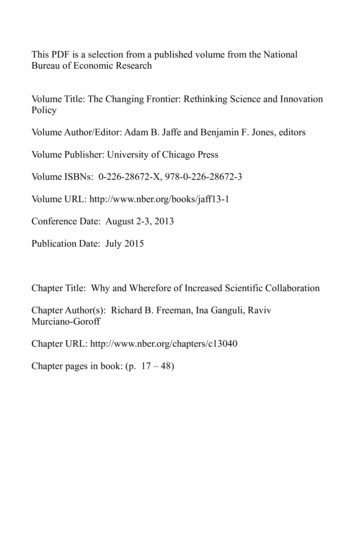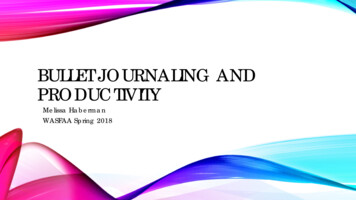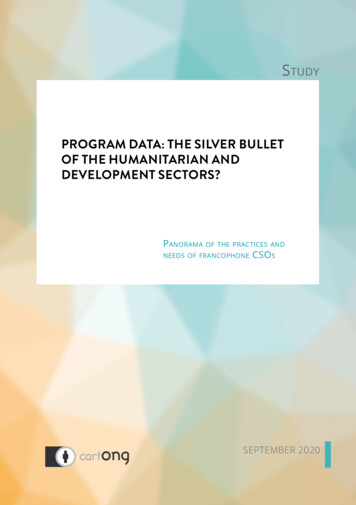
Transcription
International Journal of Media, Journalism and Mass Communications (IJMJMC)Volume 4, Issue 2, 2018, PP 1-10ISSN 001www.arcjournals.orgRethinking the Bullet Theory in the Digital AgeChinenye Nwabueze1*, Ebere Okonkwo21, 2Department of Mass Communication, Faculty of Social Sciences, Chukwuemeka Odumegwu OjukwuUniversity, Igbariam Campus, Nigeria*Corresponding Author: Chinenye Nwabueze, Department of Mass Communication, Faculty of SocialSciences, Chukwuemeka Odumegwu Ojukwu University, Igbariam Campus, NigeriaAbstract: This study examined the relevance of the Magic Bullet theory also called the Hypodermic Needletheory in the digital age. It adopted the qualitative approach is exploring the following objectives examining the basic tenets of the Magic Bullet Theory, analyzing the arguments against the Magic Bullettheory, and examining the relevance of the Magic Bullet theory in the social media age. The analysis waspremised on two key issues which were spread by the social media – the Monkey Pox Killer Vaccine incidentof October 2017 and the Salt Water Bath incident of August 2014 during the Ebola Virus Outbreak that year.The study established that the Magic Bullet theory was still relevant today as the audience react in an„actively passive‟ manner to certain media contents. The study found what could be described as the “ZombieEffect” reaction to specific media contents by audience in the digital age, supporting the credence of themagic bullet theory in the digital age. The study recommended further studies on bullet theory using otherissues so as to further establish relevance of this theory in the digital age, contrary to postulations that thetheory is no longer relevant in contemporary society.1. INTRODUCTIONA theory is an explanation of how a phenomenon works or is likely to work. Theories are used tounderstand how things are likely to happen. A theory provides explanations for understanding aphenomenon. It is a tested and testable concept used to explain an occurrence (Nwabueze, 2014). Atheory explains realities based on objective and sustained observation, it simply says why thingshappen in certain ways (Nwodu, 2006). This underscores the pertinence of theoretical perspectives tothe explanation of patterns of behaviour or attitude within and among people (Nwabueze, 2014).Communication theories are a collection theories are a collection of ideas used to explain, predict orunderstand the pattern, nature or outcome of communication process or activity. Mass communicationtheories, therefore explain or provide understanding of how the process of mass communication takesplace in a setting or what the effects of mass communication process on the society could be(Nwabueze, 2014). Mass communication, mass media or communication-related theories are used tosimplify understanding of the communication process, pattern, activity or effects on the audience andsociety. Put in another way, mass communication theories relate the communication process andactivities to the society, the individuals, institutions, government and other elements of the society.Mass communication theories come in different categories. One of such categories is Media EffectsTheories. These are theories that explain how the mass media can influence people‟s attitude andbehaviour, including how audience members are likely to react to mass media messages (Griffin,2000; McQuail, 2010; Nwabueze, 2014). Among the media effects theories is the Bullet Theory alsoknown as the Hypodermic Needle theory.The bullet theory, magic bullet theory or hypodermic needle theory sees the mass media as having adirect, immediate and powerful effect on its audiences. Theory is one of the earliest theories in thefield of mass communication. It basically says that an intended message is directly received andwholly accepted by the receiver. The theory is known by other names as well: Magic Bullet Theory,Transmission-Belt Model and Hypodermic-Syringe Model (Communication Studies, 2017).Interestingly several theories have emerged to arguably caricature the substance of the bullet theory asan all powerful effect theory (McQuail, 2005). In the 1940s, Lazarsfeld disproved the "magic bullet"theory and "hypodermic needle model theory" through elections studies in "The People's Choice" andInternational Journal of Media, Journalism and Mass Communications (IJMJMC)Page 1
Rethinking the Bullet Theory in the Digital Ageintroduced the idea of the two-step flow of communication that same year (Griffin, 2000; McQuail,2005). Other notable theories that emerged to counter the postulations of the magic bullet theoryinclude the two step flow theory, as well as the uses and gratification theory seem to oppose thepassive audience leaning of the bullet theory hence this analytical paper which seeks to revisit thesubstance of the bullet theory within the context of the social media occasioned by the advancementin the information and communication technologies.However, the emergence of Information and Communication Technologies (ICTs) has changed theface of communication. These technologies have enhanced communication patterns and influencedoutcomes in diverse ways. This means that early theories which existed prior to the emergence ofICTs and were disproved by some other theories, may require reassessment in the modern age toascertain their relevance. It is against this backdrop that this study focuses on the magic bullet orhypodermic needle theory with a view to ascertaining its relevance in this social media age.1.1. Statement of ProblemInformation and Communication Technologies (ICTs) have changed the face of communication. Theemergence of the New Media has provided the audience with diverse channels of informationreception and assimilation. This is invariably comes with diverse influences on the audienc.The “bullet theory” or "hypodermic needle theory" implied mass media had a direct, immediate andpowerful effect on its audiences. The theory suggests that the mass media could influence a very largegroup of people directly and uniformly by „shooting‟ or „injecting‟ them with appropriate messagesdesigned to trigger a desired response. However, several scholars led by Lazersfeld countered thistheory as having a wrong impression of media effect on the audience. New assessments that theMagic Bullet Theory was not accurate came out of election studies in "The People's Choice,"(Lazarsfeld, Berelson and Gaudet, 1944/1968). The opposing scholars opined that the media do nothave an all powerful effect on the audience but that the audience had the power to make decisions onhow to utilize media content (Griffin, 2000; McQuail, 2005).However, with emerging trends in the digital age, especially the influence of the social media on theaudience, there seems to be a possibility that magic bullet theory may have found relevance in themodern age. Whether this notion of fresh relevance of bullet theory is logically true is what thisanalytical work seeks to ascertain. This is in the light of recent incidents in Nigeria, one of which isthe chaos that transpired in South Eastern states when people ran to primary and post-primary schoolsto withdraw their kids based on social media stories that the Nigerian Army was killing usingPhantom Monkey Pox vaccination. This pandemonium began with social media reports of the allegeddeaths in the schools. People did not pause to consider the truth behind the social media reports butrushed to schools to with draw their children, causing pandemonium. This created an impression thatsocial media reports could be taken hook, line, and sinker by the audience and acted upon withoutconsidering the truth behind the facts. This was why the researcher decided to look at this issue inrelation to the bullet theory which has been debunked by scholars1.2. Objectives of StudyThe basic objective of this study is to examine the relevance of Magic Bullet Theory in the SocialMedia age. Specifically, the seeks to; Examine the basic tenets of the Magic Bullet Theory. Analyze the arguments against the Magic Bullet theory. Examine the relevance of the Magic Bullet theory in the social media age.2. HISTORY OF THE BULLET THEORYThe Bullet theory was propounded by Harold Lasswell after World War I. The theory emerged in the1930s hence dominated thought on the quality and quantity of effect media messages do have on thetarget audience members (McQuail, 2005). As radio, movies and advertisements gained vastpopularity between the 1930s and 1950s, the media‟s effects on people‟s behavior seemed all tooapparent and, in some cases, extremely frightening (Communication Studies, 2017). Newspaper andmagazine ads spurred on American consumerism, drawing even thrifty people into glitteringdepartment stores. President Franklin D. Roosevelt‟s radio speeches, known as the “fireside chats,”International Journal of Media, Journalism and Mass Communications (IJMJMC)Page 2
Rethinking the Bullet Theory in the Digital Ageinspired millions of citizens to support his New Deal policies in the wake of the Great Depression.Adolf Hitler used the media to spread Nazi propaganda in Germany, creating a unified force bent onconquering Europe (Communication Studies, 2017). To the common observer, people truly seemedpowerless to resist the messages that came from the media. For the first time, messages were craftedwith the target audience in mind to achieve specific responses.During this time, behavioral scholars began to study the media‟s effects in earnest. HypodermicNeedle Theory was one of the first models to result from these early studies. However, the theoryrelied on traditional inductive reasoning with observation to support it, rather than modern deductivereasoning backed by methodical testing. Scholars were still trying to establish empirical methods fortesting behavioral theories at the time.In view of this therefore the substance of the bullet theory that the media messages do have direct andmaximal influence on the target audience was used to analyze how media contents (propaganda)influenced the minds of the target audience in the second world war. According to CommunicationTheory (2017) during the Second World War media played a vital role in both United States andGermany at influencing the minds of the people. The theory was therefore used to glorify Germany‟suse of film and propaganda as well as United States use of films such as “it happened one night” andMr. Smith goes to Washington” in the war time.Despite its glorified substance, scholars have continued to describe the bullet theory as outdated andof no relevance in this technological age. One of such scholars is Paul Lazerfield and his two stepflow theory. Paul Lazerfeld subjected the bullet theory to empirical test in 1940 using the USApresidential election as a reference point; and concluded that mass media contents do not have directinfluence on the target audience but through the instrumentality of the opinion leaders. This findinghas no doubt provided basis for other theories that emerged to caricature the substance of the bullettheory hence this study titled “rethinking the bullet theory in the digital era”2.1. Basic Tenets of the Bullet TheoryThe bullet theory or hypodermic needle theory postulates that the media (needle) injects the messageinto audience mind hence causes changes in audience behavior and psyche towards the message. Thistheory therefore refers to mass media audience members as passive and hence at the mercy of massmedia contents. It therefore holds that persuasive media contents achieve the desired attitudinalchange from the target audience (Griffin, 2000; McQuail, 2005).Baran and Davis (2012) therefore note that in magic bullet theory “the rational mind is a mere façade,incapable of resisting powerful messages”. In this instance therefore Lowey and Defleur (1995, p.4)explain the substance of the bullet theory thus: Because people‟s actions are not influenced by social ties and are guided by uniform instincts,individuals attend to events (such as media messages) in similar ways. People‟s inherited human nature and their isolated social condition lead them to receive andinterpret media messages in a uniform way. Thus media messages are like symbolic “bullets” striking every eye and resulting in effects onthought and behaviour that are direct, immediate, uniform and therefore powerful.The bullet theory is therefore based on assumptions not on research findings;, it is therefore “based onassumption of human nature”. This underscores why media scholars like Paul Lazarfield and HertaHerzog do not totally subscribe to the bullet theory even though they testified to the bullet theory in1938 in a radio broadcast (the War of the Worlds) which gained wide spread reaction and panicamong the American mass audience (Lowey and Defleur, 1995, p.4).Several factors according to Communication Theory (2017) contributed to their strong effects of themass media. They include: The first rise and popularization of radio and television. The emergence of the persuasion industries, such as advertising and propaganda. The Payne Fund Studies of the 1930s which focuses on the impact of motion pictures onchildrenInternational Journal of Media, Journalism and Mass Communications (IJMJMC)Page 3
Rethinking the Bullet Theory in the Digital Age Hitler‟s monopolization of the mass media during WW II to unify German public behind theNazi party.In summary therefore the bullet theory implies that mass media contents do have direct, immediateand powerful effect on its audiences. The Hypodermic Needle Theory promotes a few basicassumptions (Griffin, 2000; McQuail, 2005): Humans react uniformly to stimuli. The media‟s message is directly “injected” into the “bloodstream” of a population like fluidfrom a syringe. Messages are strategically created to achieve desired responses. The effects of the media‟s messages are immediate and p
known as the Hypodermic Needle theory. The bullet theory, magic bullet theory or hypodermic needle theory sees the mass media as having a direct, immediate and powerful effect on its audiences. Theory is one of the earliest theories in the field of mass communication. It basically says that an intended message is directly received andFile Size: 740KBAuthor: Chinenye Nwabueze, Ebere OkonkwoPage Count: 10Publish Year: 2018











